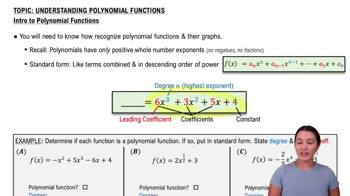Table of contents
- 0. Functions7h 52m
- Introduction to Functions16m
- Piecewise Functions10m
- Properties of Functions9m
- Common Functions1h 8m
- Transformations5m
- Combining Functions27m
- Exponent rules32m
- Exponential Functions28m
- Logarithmic Functions24m
- Properties of Logarithms34m
- Exponential & Logarithmic Equations35m
- Introduction to Trigonometric Functions38m
- Graphs of Trigonometric Functions44m
- Trigonometric Identities47m
- Inverse Trigonometric Functions48m
- 1. Limits and Continuity2h 2m
- 2. Intro to Derivatives1h 33m
- 3. Techniques of Differentiation3h 18m
- 4. Applications of Derivatives2h 38m
- 5. Graphical Applications of Derivatives6h 2m
- 6. Derivatives of Inverse, Exponential, & Logarithmic Functions2h 37m
- 7. Antiderivatives & Indefinite Integrals1h 26m
- 8. Definite Integrals4h 44m
- 9. Graphical Applications of Integrals2h 27m
- 10. Physics Applications of Integrals 2h 22m
4. Applications of Derivatives
Differentials
Problem 17b
Textbook Question
Evaluate the following limits. Use l’Hôpital’s Rule when it is convenient and applicable.
lim_x→2 (x² - 2x / (x² - 6x + 8)
 Verified step by step guidance
Verified step by step guidance1
First, substitute x = 2 into the expression to check if the limit results in an indeterminate form. Calculate the numerator: x² - 2x = 2² - 2(2) = 0. Calculate the denominator: x² - 6x + 8 = 2² - 6(2) + 8 = 0. Since both the numerator and denominator are zero, the limit is in the indeterminate form 0/0, so l'Hôpital's Rule can be applied.
Apply l'Hôpital's Rule, which states that if the limit of f(x)/g(x) as x approaches a value results in 0/0 or ∞/∞, then the limit can be found by taking the derivative of the numerator and the derivative of the denominator separately. Differentiate the numerator: d/dx(x² - 2x) = 2x - 2.
Differentiate the denominator: d/dx(x² - 6x + 8) = 2x - 6.
Now, substitute x = 2 into the new expression obtained after applying l'Hôpital's Rule: (2x - 2) / (2x - 6).
Evaluate the limit of the new expression as x approaches 2. Substitute x = 2 into the expression: (2(2) - 2) / (2(2) - 6). Simplify the expression to find the limit.
 Verified video answer for a similar problem:
Verified video answer for a similar problem:This video solution was recommended by our tutors as helpful for the problem above
Video duration:
2mPlay a video:
Was this helpful?
Key Concepts
Here are the essential concepts you must grasp in order to answer the question correctly.
Limits
A limit is a fundamental concept in calculus that describes the behavior of a function as its input approaches a certain value. It helps in understanding the function's behavior near points of interest, including points where the function may not be defined. Evaluating limits is essential for determining continuity, derivatives, and integrals.
Recommended video:

One-Sided Limits
l'Hôpital's Rule
l'Hôpital's Rule is a method used to evaluate limits that result in indeterminate forms, such as 0/0 or ∞/∞. The rule states that if the limit of f(x)/g(x) leads to an indeterminate form, the limit can be found by taking the derivative of the numerator and the derivative of the denominator separately, and then re-evaluating the limit.
Recommended video:
Guided course

Power Rules
Factoring Polynomials
Factoring polynomials is the process of breaking down a polynomial into simpler components, or factors, that can be multiplied together to yield the original polynomial. This technique is often used in limit problems to simplify expressions, especially when evaluating limits at points where the function is undefined, allowing for easier computation.
Recommended video:

Introduction to Polynomial Functions







